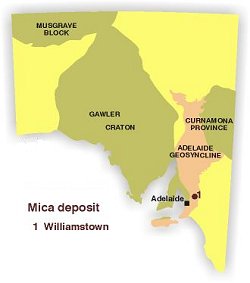 Mica is a generic name given to a group of complex hydrous aluminosilicate minerals that crystallise with a sheet or plate-like structure. Micas are common rock-forming minerals found in igneous and metamorphic rocks. Muscovite (potassium mica), phlogopite (magnesium mica) and vermiculite (a hydrated mica usually of biotitic composition — magnesium–iron mica) are most important commercially.
Mica is a generic name given to a group of complex hydrous aluminosilicate minerals that crystallise with a sheet or plate-like structure. Micas are common rock-forming minerals found in igneous and metamorphic rocks. Muscovite (potassium mica), phlogopite (magnesium mica) and vermiculite (a hydrated mica usually of biotitic composition — magnesium–iron mica) are most important commercially.
Sheet muscovite and phlogopite have high thermal resistance and low electrical conductivity, and have traditionally found applications in heating and electrical appliances. Dry and wet-ground mica are produced in larger volumes for plasterboard, plasterboard joining cements, and fillers in paint and plastic. Annual consumption world wide is less than 300 000 t.
Vermiculite is usually sold in exfoliated form, produced by heating to ~870°C which drives off the contained water as steam, resulting in an 8–10-fold expansion. The lightweight product is used as acoustic insulation, filling in lightweight wallboard, heat insulation, packing material, soil conditioner and plant growing medium. Largest producers are South Africa and United States which account for more than half the annual world production of 500 000 t. The only Australian production of vermiculite is a small amount sourced from Northern Territory at Mud Tank in the Harts Range, ~100 km northeast of Alice Springs.
Fine-grained pale green muscovite mica is selectively mined by Unimin Australia Ltd from shear zones in the Williamstown kaolin–sillimanite deposit, 40 km northeast of Adelaide. The mica is used as a filler in plasterboard and paint, as a surface coating on welding rods, a release agent for coating foundry moulds, and as spray-on decorative glitter. Production is ~1000 t/year. Vermiculite is also present in the Williamstown deposit but has low expansion properties and has not been sold commercially.
Small quantities of mica have been produced from pegmatite in the Olary district as a by-product of feldspar or beryl mining.
Additional Reading
Barnes, L.C., 1990. Williamstown kaolin–sillimanite–mica deposits. In: Hughes, F.E. (Ed.), Geology of the mineral deposits of Australia and Papua New Guinea. Australasian Institute of Mining and Metallurgy. Monograph Series, 14:1163-1166.


